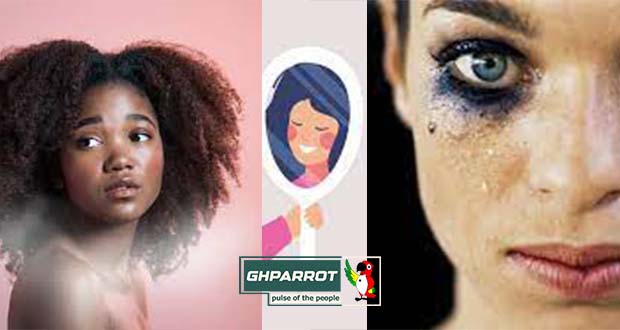How Beauty Obsession Secretly Destroys Your Mind – Shadow
The hidden cost of beauty obsession on mental health

An in-depth look at How Beauty Obsession Secretly Destroys Your Mind, how modern beauty pressures from social media filters to an expanding cosmetic-procedure industry — are quietly damaging minds, bodies and communities in Ghana and beyond.
We live in an era where a perfect selfie, a trending cosmetic procedure or a “glow” product can promise social capital, jobs and romantic attention. But behind the glossy feeds and booming clinic bookings lies a quieter toll: rising anxiety, depression, body-dysmorphic concerns and harmful behaviours — many of them preventable. This article examines the evidence, the local Ghanaian realities (skin-bleaching, body stigma), and practical steps communities, regulators and individuals can take to reduce harm.
Recommended:#BoysLivesMatter: Why Kobby Kyei Deserves Our Full Support
What we mean by “beauty obsession”
Beauty obsession = an excessive preoccupation with achieving socially-defined physical appearance ideals (skin tone, body shape, facial features, youthfulness) that drives repeated comparison, investment (time/money), risky behaviours (unsafe bleaching, unregulated cosmetic procedures) and psychological distress. It’s fuelled today by social media algorithms, influencer marketing, and the commercial beauty and aesthetic medicine industries.
Global scale: more procedures, more pressure
Aesthetic procedures continue to grow worldwide. The International Society of Aesthetic Plastic Surgery reported roughly 35 million surgical and non-surgical aesthetic procedures in 2023, a steady rise in the last decade. This normalization makes “tweakments” ordinary and increases expectation that appearance can (and should) be surgically optimized.
How social media and digital tools amplify harm
Multiple systematic reviews and recent studies link beauty obsession exposure to idealized, highly-edited images and appearance-focused social media activity with lower self-esteem, body dissatisfaction, depressive symptoms, and disordered eating behaviours, particularly among adolescents and young adults. Filters and “fitspiration” content create an ever-moving target: no sooner has one look been achieved than another is promoted. The evidence also points to growing associations between social-media use and features of body dysmorphic disorder (BDD) for vulnerable users.
Mental-health outcomes to watch
-
Body dissatisfaction — persistent unhappiness with appearance, a key risk factor for depression and eating disorders. PMC
-
Depression and anxiety: studies show higher rates among heavy consumers of appearance-focused content. ResearchGate
-
Body Dysmorphic Disorder (BDD): a debilitating preoccupation with perceived flaws; research suggests social media may be increasing its visibility and possibly its prevalence.
-
Disordered eating and unhealthy weight control driven by unrealistic thin/fit ideals and “detox” narratives. MDPI
The Ghanaian context: skin bleaching and local pressures
In Ghana, the pressure to conform to certain beauty norms shows in practices like skin bleaching, increased use of filters, and growing interest in cosmetic enhancements. Community studies report substantial prevalence of skin-bleaching among young adults (estimates vary by study, commonly cited ranges in some samples 26–65%), with links to perceived social advantage, job prospects and romantic desirability. Skin-bleaching carries severe physical health risks but also psychological costs: shame, anxiety, social stigma and identity conflict.
A local study in Kumasi found body image and perceived stigmatization meaningfully affected psychological wellbeing among obese women showing that body-related stigma in Ghana produces both protective and harmful responses depending on context. Looking back in time, one would ask “How then did our ancestors live beautifully that we can’t seem to continue that legacy without the need for beauty obsession?”
Recommended: RIPS Summer Internship 2026 in USA (Fully Funded) – Apply Now
Financial and healthcare costs (the visible and the hidden)
-
Direct consumer spending — money spent on products (often unregulated), repeated clinic visits, injections, and surgeries. Global industry growth shows budgets move from personal savings to installment plans, increasing household financial strain.
-
Medical complications — infections, scarring, chemical injuries from bleaching agents, adverse reactions to injectables; these create downstream health costs for individuals and public health systems. IJFMR
-
Mental-health treatment costs — untreated BDD, depression or eating disorders often require long-term psychological therapy, which is scarce and expensive in many parts of Ghana.
-
Opportunity cost — time spent chasing appearance ideals (work hours, social capital) that could be invested in education, entrepreneurship, or community life.
Who is most vulnerable?
-
Adolescents and young adults — identity formation + high social media use. PMC
-
People with pre-existing mental health conditions (anxiety, OCD tendencies). SpringerLink
-
Medical/dental students and image-conscious professionals — some studies show higher BDD risk in these groups. SpringerLink
-
Women and gender-diverse people — social pressures are frequently gendered, though men’s use of cosmetic procedures is rising. The Guardian
Cultural and commercial drivers
-
Colorism and historic legacies: Colonial and global media narratives privilege lighter skin in many societies; this creates structural incentives for bleaching or beauty obsession. ProQuest
-
Algorithms and influencers: Platforms prioritize engagement — and extreme or aspirational beauty content often performs best, pushing users toward more frequent comparison. PMC
-
Commercial profit: The beauty and aesthetic industries profit from repeat customers; normalization of minor procedures and “maintenance” treatments helps create lifelong spending patterns. ISAPS
Real voices (anecdote frame)
“I started using creams at 16 because I thought lighter skin would help with job interviews. I spent money I couldn’t afford. When the creams caused burns, I was told to hide it. I felt ashamed and anxious.” — A young woman from Accra.
Personal stories like this are common and point to both individual choices and structural pressures.
What’s being done and what should be done
Regulation & public health
-
Ban and enforcement against harmful bleaching chemicals; better product surveillance. (WHO and regional fact sheets highlight this need). WHO Files
-
Standards and credentialing for aesthetic clinics; mandatory informed consent and pre-procedure psychological screening for major cosmetic surgery. ISAPS
Education & media literacy
-
School-based programs teaching critical consumption of imagery, filter literacy and healthy body image. Evidence supports media-literacy interventions in reducing appearance comparison. ResearchGate
Mental-health access
-
Expand affordable counselling and specialized treatment for BDD and eating disorders; train frontline health workers to spot appearance-related distress. SpringerLink
Platform accountability
-
Social platforms can reduce algorithmic amplification of extreme appearance content, add friction to cosmetic procedure promotions aimed at minors, and label heavily edited content.
Community & cultural change
-
Promote positive local representations of beauty (diverse skin tones, body shapes) in advertising, entertainment and public campaigns. Ghanaian creatives and media can lead this narrative shift.
Practical guide on how to protect yourself and loved ones
-
Limit comparison triggers: mute accounts that cause envy, set app time limits, avoid endless scrolling.
-
Learn to spot edits: if every image looks “too perfect,” it likely is. Teach teenagers about filters and editing. PMC
-
Check credentials: if considering a procedure, verify clinic licensing and insist on written risks and psychological screening. ISAPS
-
Watch for red flags: excessive mirror-checking, persistent shame about a perceived flaw, hiding photos, repeated procedures despite dissatisfaction — seek a mental-health professional. SpringerLink
-
Community support: encourage open conversations about beauty pressures in families, schools, workplaces.
Beauty is not a crime! Expressing yourself and taking pride in appearance are natural. But when an industry, algorithms and long-standing social biases converge to turn self-improvement into a market of perpetual dissatisfaction, the costs are more than cosmetic. They’re psychological, financial and social. Ghana needs a balanced approach: safer products and clinics, stronger public education and mental-health access — and a cultural conversation that values people beyond their profiles and pixels.
References for further reading
-
ISAPS Global Survey 2023 — overview of aesthetic procedures worldwide. ISAPS+1
-
“Body Perceptions and Psychological Well-Being: A Review” (narrative review). PMC
-
Studies linking social media to body dissatisfaction and mental health outcomes. ResearchGate+1
-
PLOS ONE — Impact of body image and perceived stigmatization on psychological wellbeing of obese women in Kumasi, Ghana (2024). PLOS
-
WHO / Africa fact sheet — skin bleaching public-health concerns (regional). WHO Files



